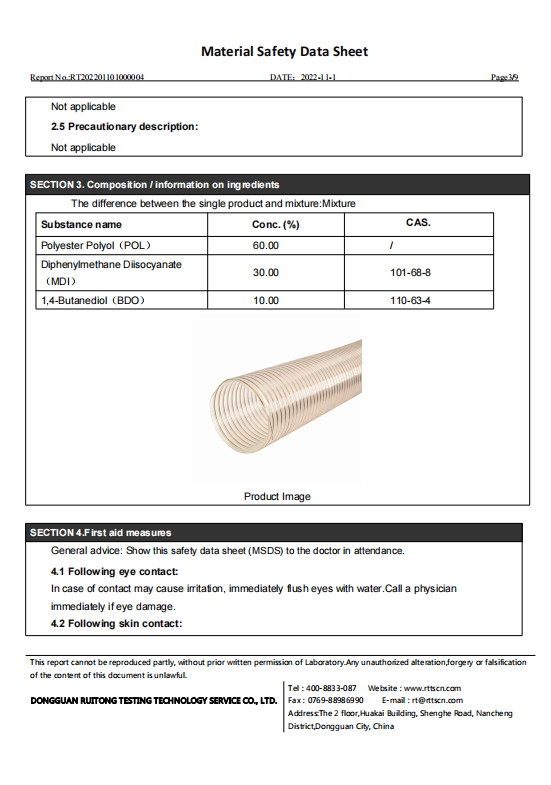flexible polyurethane tubing
Flexible Polyurethane Tubing An Overview
Flexible polyurethane tubing has emerged as a crucial component in various industries due to its unique properties and versatility. This material has found applications in medical devices, automotive systems, food processing, and numerous other sectors. In this article, we will explore the characteristics of flexible polyurethane tubing, its manufacturing process, and its diverse applications.
Characteristics of Flexible Polyurethane Tubing
Flexible polyurethane tubing is renowned for its excellent flexibility and elasticity. It can be twisted, bent, and stretched without losing its original shape, making it an ideal choice for applications that require movement and adaptability. This flexibility stems from the polyurethane polymer, which is a type of plastic known for its cushioning qualities and resistance to abrasion.
Furthermore, flexible polyurethane tubing is lightweight, which is particularly advantageous in applications where weight is a critical factor, such as in the aerospace and automotive industries. Its resistance to a wide range of temperatures also enhances its appeal. Polyurethane can withstand both high and low temperatures, making it suitable for use in varying environmental conditions.
In addition to its mechanical properties, flexible polyurethane tubing boasts excellent chemical resistance. This makes it appropriate for transporting a wide range of fluids, including corrosive liquids. Additionally, the tubing's smooth inner surface minimizes the risk of contamination, making it a perfect fit for medical applications and food processing.
Manufacturing Process
The manufacturing process of flexible polyurethane tubing involves several steps. First, polyurethane is synthesized through the reaction of polyols and diisocyanates. The resultant polymer can then be extruded through a die to form the desired tubing shape. Various additives, such as colorants or UV stabilizers, can be introduced during this process to impart specific characteristics to the tubing.
The extrusion process allows for precise control over the tubing's diameter and wall thickness, enabling the production of tubing tailored to specific applications. Following extrusion, the tubing may undergo additional processes, such as curing or heat treatment, to enhance its properties further.
Quality control is a crucial aspect of the manufacturing process. The tubing is rigorously tested for flexibility, strength, and chemical resistance to ensure that it meets industry standards and client specifications.
Applications of Flexible Polyurethane Tubing
flexible polyurethane tubing

The versatility of flexible polyurethane tubing has led to its adoption in various applications across multiple industries
.1. Medical Devices
In the medical field, flexible polyurethane tubing is used in catheters, IV lines, and respiratory devices. Its biocompatibility and flexibility make it an excellent choice for products that come into contact with the human body. The smooth inner surface reduces the risk of clot formation and ensures smooth fluid flow.
2. Automotive Industry
The automotive sector utilizes flexible polyurethane tubing for fuel lines, air intake hoses, and wiring insulation. Its lightweight nature contributes to overall vehicle efficiency, while its flexibility allows for easy installation in tight spaces. Moreover, its resistance to heat and chemicals makes it suitable for the harsh conditions often encountered in automotive environments.
3. Food and Beverage Processing
Flexible polyurethane tubing is also vital in the food and beverage industry, where it is used for transferring liquids and gases. The tubing's resistance to microbial growth and ease of cleaning make it ideal for applications that require stringent hygiene standards. Furthermore, its ability to withstand various temperatures allows for the transportation of both hot and cold products.
4. Industrial Applications
In various industrial settings, flexible polyurethane tubing is employed in pneumatic systems, spray equipment, and hydraulic systems. Its durability and flexibility contribute to the efficient operation of machinery and equipment, minimizing downtime due to maintenance or replacement.
Conclusion
Flexible polyurethane tubing is a remarkable material that plays a significant role in numerous industries. Its unique combination of flexibility, lightweight properties, and chemical resistance make it indispensable in applications ranging from medical devices to automotive systems. As manufacturing technologies continue to advance, the potential for innovative uses of flexible polyurethane tubing will likely expand even further, making it a material worth paying attention to in the years to come.
-
Unrivaled Performance and Applications of PU Pneumatic Hoses and TubesNewsJun.11,2025
-
The Transparent World of Industrial Tubing and Hosing SolutionsNewsJun.11,2025
-
The Intricate World of Pneumatic Conduits: Tubes and HosesNewsJun.11,2025
-
The Dynamic Landscape of Pneumatic Conduits: Unraveling Key ComponentsNewsJun.11,2025
-
The Diverse Applications and Significance of Transparent PVC TubingNewsJun.11,2025
-
High - Pressure Pneumatic Tubing and Systems: An In - Depth LookNewsJun.11,2025














